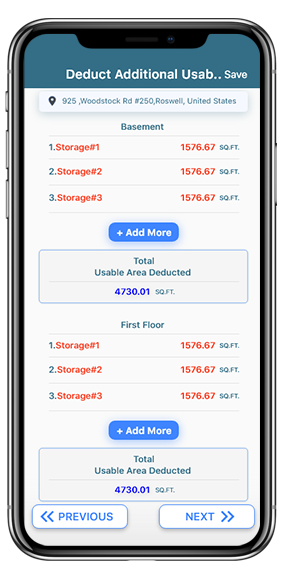In commercial real estate, rentable square footage is calculated by adding a proportion of the common areas to the usable square footage, typically using the formula RSF = USF + (USF x Load Factor). This guide aims to demystify this process, emphasizing the importance of differentiating between usable square footage and rentable square feet. It’s vital to understand the difference between usable and rentable square footage to comprehend your lease terms effectively and the total rentable area you’re committing to.
How to Calculate Rentable Square Feet from Usable Square Feet
The rentable square footage calculation depends on having accurate, usable square footage and knowing the correct load factor percentage. The formula is:
Rentable Square Feet = Usable Square Feet x (1 + Load Factor)
For example, take a space with:
- 5,000 usable square feet
- Load factor of 15%
The rentable square footage would be:
5,000 usable sq ft x (1 + 0.15) = 5,750 rentable square feet
Landlords sometimes fudge the load factor upwards to increase rentable space. Always verify usable area and load percentage when evaluating commercial real estate leases rather than relying solely on rentable square footage.
What is the Difference Between Rentable and Usable Square Footage?
The main difference between rentable and usable square footage lies in the inclusion or exclusion of a building’s common areas.
Rentable square footage refers to the total square footage of space available for lease in a commercial property. This includes the usable area that is leased to tenants as well as a proportional share of common areas like lobbies, hallways, restrooms, and stairwells. The rentable square footage is always greater than the usable square footage.
Usable square footage refers only to the actual space that is occupied and directly used by the tenant. This does not include any shared building amenities or common areas. A tenant pays rent on the rentable square footage but can only utilize the usable square footage.
Why Do Landlords Use Rentable Square Footage?
Landlords utilize rentable square footage to account for a tenant’s share of the building’s common areas and allocate operating expenses accurately. Tenants pay their portion of costs like cleaning, utilities, and maintenance based on the percentage of total rentable space they lease.
Rentable square footage allows landlords to:
- Recoup costs for shared amenities and spaces
- Compare spaces on an apples-to-apples basis
- Calculate accurate rental rates per square foot
Without using rentable square footage, landlords would undercharge for space or be unable to cover full building operating expenses.
What Factors Determine Rentable vs Usable Square Feet?
The main factor affecting the difference between usable and rentable square footage is the load factor, also known as the add-on factor or area factor. The load factor represents the percentage of a building’s common area applied to the usable square feet to calculate rentable area.
For example, a space with 1,000 usable square feet and a 15% load factor would have 1,150 rentable square feet (1,000 x 1.15). The higher the load factor, the greater the disparity between usable and rentable area.
Other factors like hallways, lobbies, amenities, and the efficiency of floor layout also impact rentable square footage. More common areas and an inefficient layout increase rentable over usable space. Newer buildings sometimes have lower load factors.
Why Rentable Square Footage Impacts Rental Rates
Rental rates in commercial leases are typically quoted on a price per rentable square foot basis. If you only consider the usable area, you may underestimate the true rental cost per square foot.
For instance, the usable rate might be $30 per square foot. But with a 15% load factor, the rentable rate becomes $26.09 per square foot ($30 x 0.85).
To accurately compare spaces, look at rent on a rentable square foot basis to avoid unexpected higher costs down the road.
Key Questions to Ask About Rentable vs Usable Square Feet
When touring potential commercial spaces, make sure to ask these key questions about rentable and usable square footage:
- What is the precise usable square footage I can lease?
- What is the quoted rentable square footage and what load factor is used?
- Can you provide a detailed breakdown of common areas and calculations used?
- How does the load factor here compare to similar spaces I am considering?
- Does the square footage align with measurement best practices like BOMA?
Do not take marketed square footage at face value. Verify the exact usable space being leased along with a transparent rentable square footage methodology before signing a lease.
Tips for Tenants Evaluating Commercial Space
As a prospective tenant, keep these tips in mind when evaluating commercial spaces using rentable and usable square feet metrics:
- Independently measure usable area rather than relying on marketed figures
- Ask about load factor percentages and common area breakdowns
- Compare load factors of all spaces under consideration
- Calculate costs using rentable rates to determine true price per square foot
- Don’t let landlords fudge usable space or inflate add-on percentages
- Require clear square footage terms and measurement details in final lease
Carefully researching both the usable and rentable square footage is vital for understanding the total cost of occupying any commercial real estate.
Streamlining Rentable Square Footage Calculations with U/R Simple
In the complex world of commercial real estate, accurately calculating rentable square footage is crucial. This is where U/R Simple, an innovative app, comes into play. Designed for architects and professional commercial draftsmen, U/R Simple streamlines the calculation process of usable and rentable square footage. The app offers four tailored calculation options, catering to different building and location scenarios, such as single-story buildings or multi-story properties with distinct load factors.
U/R Simple stands out for its ease of use and precision. It eliminates the tedious manual processes previously required, transforming property space calculations into a more manageable task. With features like property tracking, secure data storage, automatic adjustments, and the ability to export calculations, U/R Simple ensures a comprehensive user experience. It not only saves time but also enhances efficiency and accuracy in the calculation process.
The importance of accurate square footage calculations can’t be overstated. As outlined in our article, it affects lease agreements, rental costs, and overall satisfaction for both tenants and landlords. U/R Simple effectively addresses these challenges, making it a valuable tool for anyone involved in commercial real estate.
Key Takeaways on Calculating Rentable Square Footage
Remember these key points when differentiating between rentable and usable square footage:
- Rentable includes usable area + proportional share of common space
- Usable only covers actual premises being leased, not common areas
- Load factor determines the add-on percentage from usable to rentable
- Rental rates use rentable square feet to account for allocated common space
- Verify precise usable area and load factors when touring spaces
- Compare load percentages and gross versus usable ratios across spaces
- Rentable square footage impacts the true price per square foot on leases
Understanding the difference between rentable and usable square footage enables informed leasing decisions using accurate cost-per-square-foot figures. Keep these metrics in mind when evaluating any commercial real estate space. By incorporating U/R Simple into your calculations, you’re embracing the future of property space calculations, ensuring more accurate and efficient outcomes. Its user-friendly interface and advanced features position U/R Simple as a game-changer in the realm of rentable square footage calculations.




